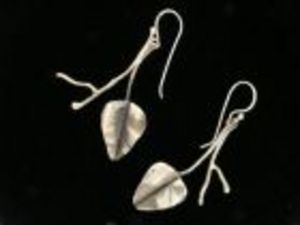What is annealing, and why is it important?
When metal is hammered, bent, rolled through a mill, or otherwise “worked”, the molecules of the metal are pressed more closely together, causing it to lose flexibility. This is known as work-hardening. If we do not stop to soften, or anneal, the metal, it will crack or split. Pieces may snap off. Stay aware of your metal, and anneal frequently when working.
How will you know when it’s time to anneal?
• Listen to the sound when you are hammering. Soft metal makes a duller thud than hard metal, which makes a higher pitched, more ringing sound.
• Feel subtle differences in how your hammer reacts to the metal. The hammer sinks into softer metal, and bounces sharply off of hard metal
• Watch the shape of the metal change. Soft metal changes shape, becoming flatter or longer, responding to the pressure of the hammer. Hard metal will keep its shape and resist changing.
• Test the metal by trying to bend it when you notice the above signs of work hardening. If the metal is hard, springy or difficult to bend, STOP hammering and ANNEAL the metal.
Setting Up an Annealing Area
On your work bench or table, create a fire resistant surface by laying out several large ceramic floor tiles, sheet metal (no zinc-plated sheet metal, this can be hazardous to your health when heated), masonite, wonderboard, etc.
On this surface, set up your area with:
• A fire brick, soldering pad, charcoal block (no barbeque briquets!) annealing pan with pumice granules, or another safe, heat-reflecting surface.
• Insulated tweezers (cross-locks are a good choice)
• A bowl of water for quenching (cooling)
• Torch (a high quality butane torch is fine if your piece is small, less than 1″ square)
• Pickle pot and pickle (opt) Pickle (sparex, pH minus, vinegar, citric acid) is an acid which will remove the discoloration (oxidation) created by the torch. It works best hot (crock pot, hot plate). It is not strictly necessary for annealing, but many prefer it.
How to Anneal
1. Mark your metal with a Sharpie permanent marker or a small amount of paste flux.
2. Place hardened metal on fire brick, with marks visible.
3. Light torch according to manufacturer’s directions.
4. Begin by warming metal gently across entire surface.
5. Bring flame in closer until the point of the blue cone is about ¼ inch from the metal. This is the hottest part of the flame.
6. Continue to move the flame constantly across the entire piece, evenly raising the temperature of the entire piece. Don’t stop the flame on any one area.
7. When the Sharpie marks you made disappear, or the flux turns glassy, you are near annealing temperature (about 1100 degrees F). Watch for the changes in color that indicate annealing temperature has been reached. If you have not annealed metal before, I suggest you turn off the lights and watch the metal as you heat it. When it begins to glow pink, you have generally achieved annealing temperature. You will want to back the flame away from the metal, but continue to heat it gently, keeping it at annealing temperature (gentle glow) for about 60 seconds to fully anneal the metal. With lights on, you will not see the same level of glow, but you will learn to recognize the changes in color that indicate that annealing has probably occurred. If the metal starts to glow so that it is visible in normal room light, you have usually exceeded the normal annealing temp, so pull the flame back and heat more gently for 60 sec. Brass needs to be annealed for longer than copper or silver, and at a higher temperature, so glow is OK.
Tips:
• Wire will heat and anneal very quickly, sheet will take longer. The thickness of the metal (gauge) and the size of the sheet or wire will make a significant difference in the annealing time.
• If noting color changes just doesn’t work for you, just watch the sharpie disappear, increase heat for a bit longer, pull back to hold heat high for 60 or more seconds, cool and quench.
• What happens if I heat too much? With copper and brass, no problem. Both melt at very high temperatures, and it’s nearly impossible with if you use a butane torch. Overheating will cause more discoloration and drive it deeper into the metal, but that’s usually the worst that will happen. With silver, both oxidation and melting are potential problems. As silver melts, it begins to get a shiny, liquid mercury look to the surface. If you begin to see this, you have raised the temperature of the silver well beyond the annealing point, which may create unwanted textures and brittleness. I strongly recommend melting a piece of scrap silver and carefully noting the changes prior to melting. Once you have seen them, you will begin to recognize the signs, and may avoid damaging a piece you hope to complete.
8. Once the metal is annealed, remove the heat and turn off the torch.
9. Allow a few seconds for the metal to cool to “black heat”, carefully pick up the metal with your insulated tweezers, and quench it by dipping it fully into the bowl of water. The metal will hiss as it quickly cools, this is normal. If it “spits” when quenched, it was too hot, wait a bit longer next time.
10. Remove the metal from the water (it is cool enough to touch almost immediately) and dry. Wet metal on your steel tools is a quick road to rust, so be sure to dry well.
11. Check for softness by gently bending the piece. If fully annealed, it should now bend easily. If not, anneal again, allowing the metal to get slightly hotter and hold for a longer period of time.
Read more of my tutorials and view my works here:
www.silvervine.etsy.com
www.silvervinejewelry.com


